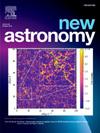银河系磁场和螺旋臂防止气体淬火由于冲压压力
IF 2.1
4区 物理与天体物理
Q2 ASTRONOMY & ASTROPHYSICS
引用次数: 0
摘要
星系团内介质(ICM)和星际介质(ISM)之间的相互作用在星系演化过程中起着至关重要的作用。对星系团的调查表明,冲压压力剥离(RPS)是去除星系团中冷气藏的主要机制。我们扩展了Singh等人(2019)的柱塞压力剥离分析模型,以包括圆盘中的不对称性,例如螺旋臂和沿螺旋臂的规则磁场。来自磁场的非热压力与撞击压力相反,导致星系中更大的气体潴留。我们对具有磁场的螺旋星系的分析模型表明,当星系靠近星系团的核心时,一个强度为10−5 G的强磁场显著增强了星系中心的气体保留,从而抑制了剥离率。我们发现,大于10−6 G的磁场对于将气体一直保留到星团中心至关重要。虽然磁场和星系质量都有助于气体的保留,但磁场的影响尤其显著,特别是在不存在异常高质量的典型螺旋星系中。我们的结果可能有助于解释为什么尽管剥离力很强,但在密集的星系团环境中仍然可以观察到富含气体的星系。本文章由计算机程序翻译,如有差异,请以英文原文为准。
Galactic magnetic field and spiral arms against gas quenching due to Ram pressure
Interaction between the intracluster medium (ICM) and the interstellar medium (ISM) plays a crucial role in galaxy evolution. Surveys of galaxy clusters have shown that ram pressure stripping (RPS) is a dominant mechanism that removes the cold gas reservoir from cluster galaxies. We extend the analytical model for ram pressure stripping by Singh et al. (2019) to include asymmetries in the disc, such as spiral arms and regular magnetic fields along the spiral arms. Non-thermal pressure from magnetic fields acts against the ram pressure and leads to greater gas retention in galaxies. Our analytical modelling of spiral galaxies with magnetic fields shows that a strong magnetic field, with a strength of G, significantly enhances gas retention at the centre of a galaxy as it approaches the core of a cluster, thereby suppressing the stripping rates. We find that magnetic fields stronger than G are critical for retaining gas all the way to the cluster centre. While both magnetic fields and galaxy mass contribute to the retention of gas, the influence of magnetic fields is particularly significant, especially in typical spiral galaxies where unusually high masses are not present. Our results may help in explaining why gas-rich galaxies can still be observed in dense cluster environments despite the strong stripping forces.
求助全文
通过发布文献求助,成功后即可免费获取论文全文。
去求助
来源期刊

New Astronomy
地学天文-天文与天体物理
CiteScore
4.00
自引率
10.00%
发文量
109
审稿时长
13.6 weeks
期刊介绍:
New Astronomy publishes articles in all fields of astronomy and astrophysics, with a particular focus on computational astronomy: mathematical and astronomy techniques and methodology, simulations, modelling and numerical results and computational techniques in instrumentation.
New Astronomy includes full length research articles and review articles. The journal covers solar, stellar, galactic and extragalactic astronomy and astrophysics. It reports on original research in all wavelength bands, ranging from radio to gamma-ray.
 求助内容:
求助内容: 应助结果提醒方式:
应助结果提醒方式:


